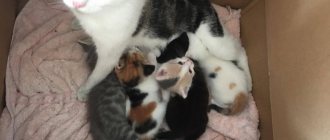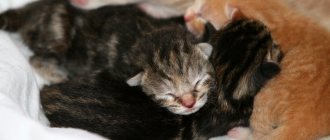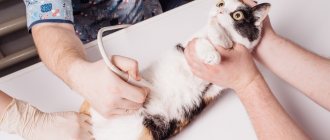Neonatal period
The development of kittens from birth until they reach ten days of age is called the neonatal period. The fastest and most amazing changes occur at this time.
The kitten is born blind and deaf, its nervous system has not yet fully formed. He navigates in space thanks to his sense of smell and touch and can find his mother at a distance of 60 centimeters. Babies spend almost all their time in hibernation, only occasionally waking up to feed on their mother's milk.
Interestingly, at this time the kittens already have some reflexes. The most important reflexes include sucking, covering and the perineal reflex, which provokes defecation and urination. The fact is that a newborn kitten cannot control these processes. By licking the baby's belly, the cat stimulates the cleansing process of his body. If the kittens are left without a mother, in the first few weeks, after feeding the kittens, the owner should help them defecate by massaging the abdomen and perineum.
At about 5-8 days of life, the kitten’s ear canal opens and the kittens begin to hear. Therefore, during this period it is important to provide them with peace and quiet.
When should your eyes open?
The time for cubs to gain insight may be determined by hereditary factors.
In the first weeks, cats navigate in space thanks to their sense of smell and touch, and begin to open their eyes 10-14 days after birth. But this process does not occur according to a clear schedule. The following factors may influence the time at which cats open their eyes:
- breed of animal;
- genetic inheritance;
- due date;
- biological sex.
Features of discovery according to breed
The length of the fur in cats affects the opening time of the eyelids. The longer it is, the slower the process of development of the cubs takes place. Sometimes deviations between species reach 5-7 days. The periods during which kittens open their eyes depend on the breed. According to observations, they are as follows:
- Sphinxes, Devon Rexes. The opening of the eyelids in short-haired breeds occurs in a short period of time. Babies begin to see the light in 5 days, and by the 10th day they begin to walk and become active.
- British, Scottish, Siamese, Bengal newborns. It will take kittens about 7 days to start seeing. British ones open their eyes on day 8, Siamese on day 5, but Scottish Folds need extra time. It will take another 2-3 days for vision to become more active.
- Persians and Maine Coons. Unlike their British and Scottish brothers, they remain with their eyelids closed for a long time. It will take a couple of weeks for newborns to open them.
- Regular or yard cats. They begin to see depending on the pedigree of their parents; each of these babies’ eyes open at their own time. Girl kittens open them earlier than cats.
How do eyelids open?
First, the inner corners of the visual organs open in babies.
The process of opening the visual sense organ is divided into stages and lasts three days. First, the eyelids open to the point of a small slit in the inner corner of the eye, and at the same time tears accumulate there. Gradually, the opening angle increases, the gap spreads and two eyelids become clearly visible: lower and upper. The first day the pupil is not yet noticeable and not active, the cornea is cloudy, so surrounding objects are not visible to them.
At the age of 2-3 weeks, kittens see objects, but only at a distance of about 3 meters. At first, everyone's eyeballs are pale blue. The pigmentation process will take place over three weeks, but the final color will only be established at 6 months. By this same period, brightness, clarity and saturation will be fully formed.
Transition period
This stage begins from the moment the kittens' eyes open and lasts until the animals begin to walk. From about 10 to 15-20 days.
At this time, the kitten begins to hear and see the world around it. In addition, the musculoskeletal system is strengthened, and the kitten begins to walk a little.
The transition period marks the beginning of the kittens' socialization, when they develop attachments to each other and to their mother. At this time, favor and affection for the person is also established. To make a cat tame and affectionate, it is important to gradually establish contact with the kitten. The owner needs to pick up the kitten and caress it, increasing the time from 2-3 minutes at first to 40 minutes daily.
Also during the transition period, the role of the mother as a teacher and controller increases. With the help of games and communication, she regulates the behavior of kittens, teaches them the basics of hunting and interaction with the outside world. The owner can also take part in this process. It is important to introduce your kitten to new smells and sensations through toys and other safe objects.
Other popular questions
On the 9-10th day from birth, kittens' ear canals open and they begin to distinguish sounds.
When does a kitten start walking?
By the first month of life, babies begin to stand on shaky legs and learn to stand, and then walk. True, they still cannot walk confidently, but this is temporary. By the age of one and a half months, pets will be running around like crazy and exploring every nook and cranny of the home with curiosity.
When does a kitten go to the toilet on its own?
Again, by the age of one month, the babies have established an independent process of defecation and urination. By this period, the mother cat not only helps the babies relieve themselves, but also begins to slowly train them to use the toilet.
When to switch to an adult diet?
While the kitten is suckling from the mother, it is not necessary to feed it. After a month, he begins to get out of the cozy nest and follow his parent everywhere. This is exactly the time when you can put a saucer with food for the baby in the kitchen next to the mother’s bowl and slowly accustom him to solid food.
As complementary foods, pureed yolk and cottage cheese are used and finely chopped minced meat or special canned food for kittens is placed on a plate. It is not a fact that the baby will immediately rush to new food. At first, he will simply sniff, but hunger and innate reflexes will take over, and gradually the baby will begin to eat the foods offered. By the age of two months, the kitten can be completely weaned from mother's milk and transferred to a cat diet adapted for the baby.
When do teeth cut?
The first teeth in kittens appear at the age of 2 weeks; by the end of 3 months, the dental system is fully equipped with the required number of incisors, molars and premolars. And by the age of 5 months, the replacement of milk teeth with permanent ones begins.
Is it possible to influence development?
Some owners are sure: massage helps speed up the development of the kitten, making it strong and resilient. How true this is is difficult to judge.
It is worth noting that if you take babies in your arms more often and constantly squeeze them, the cat will get rid of the foreign smell by licking the child. A rough tongue stimulates blood circulation and enhances metabolism. However, not all mothers react adequately to the fact that their babies are constantly being caressed. In the best case, she will drag them to a secluded corner, in the worst case, she may completely abandon the offspring.
Video story about kittens that have just opened their eyes:
Socialization period
This stage lasts from approximately three to ten weeks. During this period, the development of kittens is associated with the distribution of social roles. The owner can notice the developed character of the kids.
At this stage, the final formation of self-care skills and the instillation of cleanliness occurs, when kittens learn to go to the litter box and wash themselves.
Around this time, the kittens' first vaccination and medical examination take place. Your veterinarian can create a complementary feeding plan as animals gradually wean themselves off their mother's milk. But, despite the apparent maturity and independence, it is still not recommended to separate kittens from their mother.
Subscribe to the newsletter and get a discount at the pet store “Lubimchik”
Thanks for subscribing!
How are kittens born?
All newborn kittens look almost the same - they are small, smooth lumps with flattened ears and thin tails, weighing only about 100 g
They are helpless and completely dependent on their mother - they cannot see or hear, they cannot empty themselves and regulate their body temperature, which is why it is so important that they are kept warm. Babies only sleep, squeak and suck nutritious milk, drinking 5–10 ml at a time
They search for their mother based on smell and are able to find her within 60 cm of them.
Pregnancy in felines does not last long. This is what nature provided, because a cat is a predator that obtains food by hunting, and hunting with a huge belly is not easy. By the time of birth, many organs, including the visual ones, do not yet have time to complete their formation.
The eyes of newborn babies are very sensitive to light. The eyelids protect the eyes from its effects. They open only when the babies are ready to see the light. When the cubs are still in the womb, closed eyelids protect the organs of vision from infections, because the amniotic fluid in which they exist is far from sterile.
Juvenile period
The juvenile stage begins at approximately 11 weeks and lasts until puberty, which is four to five months. The kitten becomes hyperactive and curious. The owner’s task is to ensure his safety during this period. At the age of three months, the kitten has excellent spatial orientation, knows its name, is litter box trained and is independent of its mother. This means that this is the best time to transfer it to new owners.
The development of kittens by week ends at approximately three months. Further maturation slows down. At this time, the muscle corset is strengthened and the teeth are finally replaced. The period of puberty begins. Cats become adults at about one year of age.
When do newborn kittens' eyes open?
You've probably wondered why newborn kittens have their eyes closed? During the formation of embryos, the kittens' eyelids close using a thin film that remains intact after birth. The reason is that the pupils of kittens are not ready for active work, and the free passage of light through the lens can lead to retinal burns.
Immediately after birth, for survival, although there it is necessary to hear smells and feel vibrations. Mother cat has a unique smell that kittens react to
While feeding, the cat purrs, which attracts the attention of the offspring.
In the wild, kittens are born blind for another reason that their unintentional exit from the nest is guaranteed to lead to death. Newborn kittens cannot control their own body temperature, and blindness prevents them from crawling far from the nest and littermates.
How long do kittens remain blind after birth?
Of course, domestic kittens do not grow up in such extreme conditions, but they remain blind after birth. At a normal rate of development, kittens begin to open their eyes between 3 and 4 weeks of age. The film breaks in the center and gradually thins towards the corners of the eyes. With the appearance of gaps in the eyelids, the mucous membranes of the kittens' eyes begin to work more actively, gradually adapting to the influence of the environment.
Even if your eyes have already begun to open, do not pull your eyelids, guided by an attempt to help
If the kitten has some kind of inflammatory process, the eyelids look puffy or swollen, they need to be looked after with the utmost care.
At what age do kittens begin to see clearly?
At 4–5 weeks of age, kittens fully open their eyes and begin to see the world. However, their vision is not yet focused. The reason is that the pupil contracts and dilates more slowly than in adult cats.
Most of the time, the pupil is in a contracted state to protect the retina from burns. It is for this reason that the kittens’ nest must be located in a dark place.
How the eyes open
The opening takes place in several stages. At first, the animals begin to raise their eyelids. A small crack appears. It occurs either along the entire length of the eyelids or in one corner. The pupils can already be seen, but they are still cloudy. After a couple of days, the kitten opens its eyes completely.
But for the first few days, babies see almost nothing, only light and shadows during the day. Only towards the end of the first month of life does the kitten begin to see. Then the baby will actively explore the world around him and crawl. But his iris color is not yet final. Most cats are born with blue eyes and only then do they acquire their permanent color.
In order for the whole process to go without unnecessary problems, it is necessary to make it as natural as possible. Remember that babies are very vulnerable to infections and other threats. You need to protect your small pets from them.
Loading …











